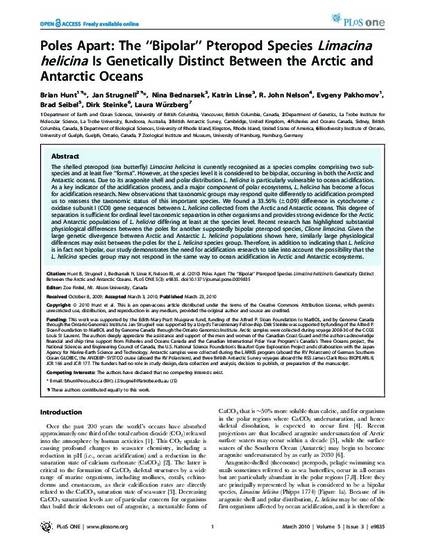
The shelled pteropod (sea butterfly) Limacina helicina is currently recognised as a species complex comprising two sub-species and at least five “forma”. However, at the species level it is considered to be bipolar, occurring in both the Arctic and Antarctic oceans. Due to its aragonite shell and polar distribution L. helicina is particularly vulnerable to ocean acidification. As a key indicator of the acidification process, and a major component of polar ecosystems, L. helicina has become a focus for acidification research. New observations that taxonomic groups may respond quite differently to acidification prompted us to reassess the taxonomic status of this important species. We found a 33.56% (±0.09) difference in cytochrome c oxidase subunit I (COI) gene sequences between L. helicina collected from the Arctic and Antarctic oceans. This degree of separation is sufficient for ordinal level taxonomic separation in other organisms and provides strong evidence for the Arctic and Antarctic populations of L. helicina differing at least at the species level. Recent research has highlighted substantial physiological differences between the poles for another supposedly bipolar pteropod species, Clione limacina. Given the large genetic divergence between Arctic and Antarctic L. helicina populations shown here, similarly large physiological differences may exist between the poles for the L. helicina species group. Therefore, in addition to indicating that L. helicina is in fact not bipolar, our study demonstrates the need for acidification research to take into account the possibility that the L. helicina species group may not respond in the same way to ocean acidification in Arctic and Antarctic ecosystems.
PLoS ONE, v. 5, issue 3, art. e9835
© 2010 Hunt et al. This is an open-access article distributed under the terms of the Creative Commons Attribution License, which permits unrestricted use, distribution, and reproduction in any medium, provided the original author and source are credited.
Available at: http://works.bepress.com/brad-seibel/64/
